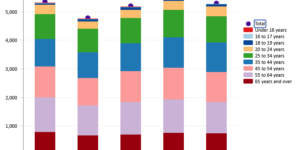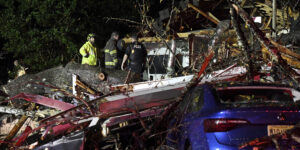Prosecutors on Friday said the CEO and four employees of the operator of a sunken South Korean ferry caused the accident by overloading the ship with poorly stowed cargo after a risky redesign and neglecting safety by spending less than $2 last year on crew training.
The defendants countered that the cause of the April disaster that left more than 300 people dead or missing wasn’t yet clear. The five had been expected to verbally enter pleas at a preliminary hearing Friday at Gwangju District Court, but their lawyers said they needed more time and would submit written pleas later. Another hearing is scheduled in three weeks.
The CEO and four executives or managers at the operator, Chonghaejin Marine Co., faced a decidedly less hostile reception Friday than the 15 crew members charged with negligence had at their hearing last week. Family members of the dead heckled and screamed at the crew members throughout that hearing. The spectators Friday, many of whom were reporters, listened quietly as prosecutors read the indictment. When Judge Lim Joung-youb asked if there were relatives of the victims present, no hands were raised.
Prosecutors indicted the company officials for alleged professional negligence and violating a law on measures required for safe maritime navigation.
The Sewol, a 6,825-ton car ferry purchased in Japan for 800 million yen ($7.8 million) in 2012, was redesigned to add cabins and create an exhibition room after its purchase, according to the indictment. The ship became top heavy as a result of the rework, so the Korean Register of Shipping approved the ship on the condition that it substantially reduce its cargo limit.
Chonghaejin is said to have continued to overload the ferry with cargo even though the company knew the ship’s redesign made it top heavy and unstable. By routinely overloading the Sewol, Chonghaejin made an extra $3 million in profit in the past year, according to the indictment.
The CEO of Chonghaejin, Kim Han-sik, 71, did not deny that the ferry was overloaded with cargo and had been redesigned but contended that it was questionable whether those factors led to the sinking, according to his lawyer, Kang Seok-won.
Defendant Nam Ho-man, who headed Chonghaejin’s cargo team, never told workers to load as much cargo as possible, didn’t know the ferry’s cargo limit and didn’t know how much cargo was loaded on the day of the accident, according to his lawyer, Kim Jun-seong.
Meanwhile, prosecutor Park Jae-eok said the five defendants neglected the passengers’ safety in return for economic benefits and must be held responsible.
Chonghaejin’s CEO encouraged managers at a weekly gathering to meet the ferry’s cargo goals even as he sought to sell the ship because of instability caused by the redesign, mounting losses and too much cost, Park said. If the cargo goal was not met, the weekly meeting was used to caution employees, he said.
The prosecutor also said that the employees at Chonghaejin were responsible for the captain and crew’s abandonment of the sinking ship and the failure to protect passengers because they did not oversee sailors’ emergency training and spent only $2 on training last year. That money covered the fee for issuing a paper for a sailor who received education elsewhere, Park said.
The Sewol sinking has caused widespread grief and fury and has prompted South Korea to reassess its long history of disregarding safety as it pursued economic growth. President Park Geun-hye has publicly apologized and reshuffled her Cabinet.
All but one of 15 crew members responsible for navigating the ferry have pleaded not guilty to charges linked to their alleged failure to protect passengers, who were mostly high school students on a school trip.
The crew members, including the captain, said through their lawyers that their employer was responsible for the ship’s sinking because sailors had no control over cargo. They said the coast guard was responsible for rescuing the passengers.
A total of 292 bodies have been recovered and 12 people are still missing from the ferry sinking, one of the most deadly peacetime disasters in South Korea.





















 California Vocational School CEO Charged With 23 Counts of Insurance Fraud
California Vocational School CEO Charged With 23 Counts of Insurance Fraud  Surviving the ‘Silver Tsunami’: Closing the Talent, Skills Gap in Underwriting
Surviving the ‘Silver Tsunami’: Closing the Talent, Skills Gap in Underwriting  Weak La Nina Expected in the Central Region of the U.S. This Winter: NWS
Weak La Nina Expected in the Central Region of the U.S. This Winter: NWS  New Regulations Ramping Up Association Costs Frustrate Florida Condo Owners
New Regulations Ramping Up Association Costs Frustrate Florida Condo Owners 
